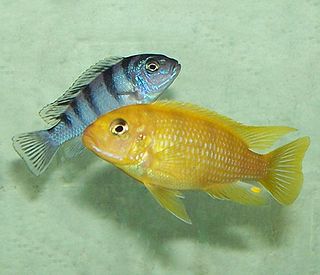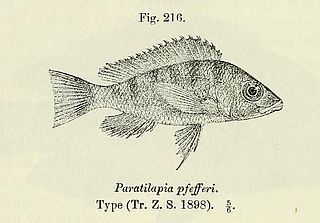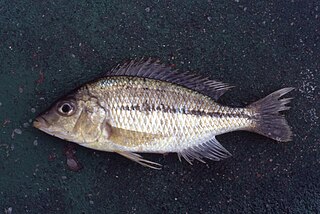
Heterotilapia buttikoferi, also known as the zebra tilapia, is a West African species of cichlid.

Neolamprologus brichardi is a species of cichlid endemic to the alkaline waters of Lake Tanganyika in East Africa. It is a popular aquarium fish kept in the fishkeeping hobby, where it is known under a variety of common names including Princess cichlid, Princess of Burundi, Lyretail cichlid, Fairy cichlid and Brichard's lamprologus. In addition, the species is also the subject of numerous studies on fish behaviour. It is closely related to N. pulcher from the southern half of Lake Tanganyika and some have recommended merging the two into a single species.

Maylandia lombardoi, is a 13 centimetres (5.1 in) long freshwater fish from the family Cichlidae. This species is popular in the aquarium hobby where it is sold under a variety of common names including: lombardoi mbuna, kenyi mbuna or kennyi mbuna or kenyi cichlid. This species is sometimes seen in the genus Metriaclima owing to a dispute in which a minority of cichlid researchers do not consider Maylandia valid (see Maylandia for discussion. The specific name honours the exotic fish dealer John Lombardo.

Iodotropheus sprengerae, the rusty cichlid, lavender mbuna or lavender cichlid, is a species of cichlid endemic to the Boadzulu and Chinyankwazi Islands and Chinyamwezi Island regions of Lake Malawi. It prefers a temperature range of 24-26 °C.

Nimbochromis livingstonii, Livingston's cichlid or (locally) kalingono, is a freshwater mouthbrooding cichlid native to Lake Malawi, an African Rift Lake. It is also found in the upper Shire River and Lake Malombe. They are found in inshore areas of the lake over sandy substrates.

The giant cichlid, also known as the emperor cichlid, is a species of fish in the family Cichlidae, endemic to Lake Tanganyika in Africa. It is the only member of its genus Boulengerochromis and tribe Boulengerochromini.

Gnathochromis pfefferi is an African species of fish in the family Cichlidae. It is endemic to Lake Tanganyika and its slow-flowing tributaries in the countries of Burundi, the Democratic Republic of the Congo, Tanzania and Zambia. It is common and widespread. This cichlid is found in relatively shallow waters, typically over soft bottoms in places with aquatic grasses.
Astatotilapia flaviijosephi, the Jordan mouthbrooder, is a vulnerable species of freshwater fish in the family Cichlidae (cichlids). It is found in the central Jordan River system, including Lake Tiberias (Kinneret), in Israel, Jordan and Syria, making it the only haplochromine cichlid to naturally range outside of Africa. This species is too small to be of significant importance to fisheries, unlike the only other cichlids native to the Levant, the economically important tilapias.

Astatotilapia stappersii is a ray-finned fish species in the family Cichlidae. Adults measure about 15 cm (6 inches) in total length.

The convict julie is a cichlid species in the subfamily Pseudocrenilabrinae family endemic to Lake Tanganyika. Hence it is found in Burundi, the Democratic Republic of the Congo, Tanzania, and Zambia. The fish is named after Charles Tate Regan.

Limnotilapia dardennii, the latticed cichlid, is a species of cichlid endemic to Lake Tanganyika, where it prefers rocky areas near the coast. It may also be found in the aquarium trade. This species is currently the only known member of its genus.
The threadfin cichlid is a species of cichlid endemic to Lake Tanganyika found in areas with rocky substrates on which it can graze on algae. This species can reach a length of 18 cm (7.1 in). It can be found in the aquarium trade. The specific name of this cichlid honours the British ichthyologist Ethelwynn Trewavas (1900-1993).
The fenestratus is a species of cichlid fish endemic to Lake Malawi in East Africa. This species can reach a length of 14 centimetres (5.5 in) TL. It can also be found in the aquarium trade. Protomelas fenestratus is a substrate blower. They blow away the substrate, to uncover insect larvae and crustaceans. They are characterized by vertical bars, and thin horizontal lines of varying darkness depending on location. The males blue colouration obscures the barring when dominant. The lattice like pattern on this fish's body is reminiscent of windows which is what the specific name fenestratus refers to.

Protomelas kirkii is a species of cichlid endemic to Lake Malawi where it is most commonly found in areas vegetated with Vallisneria. This species can reach a length of 18 centimetres (7.1 in) TL. This species can also be found in the aquarium trade.
Tropheus brichardi is a species of cichlid endemic to Lake Tanganyika where it is found in areas with substrates of solid rock in the central portion of the lake. This species can reach a length of 10 cm (3.9 in). It can be found in the aquarium trade. The specific name honours Pierre Brichard (1921-1990) the aquarium fish exporter who provided the authors with the type.
Enteromius brichardi is a species of cyprinid fish native to the Republic of the Congo and Gabon. This species can reach a length of 8 centimetres (3.1 in) TL.

Tilapia sparrmanii, the banded tilapia, or vlei kurper, is a widespread and adaptable cichlid fish that is found in warmer freshwater habitats of southern Africa. They prefer water with ample plant cover, and occur naturally as far north as DR Congo and Tanzania. They have been introduced locally in the northern hemisphere. Younger banded tilapia feed on crustaceans and insect larvae, while the adults feed on terrestrial and aquatic plants and other debris. They undertake local migrations and may shoal before and during spawning time. They guard their own eggs, and although they may move eggs or fry in the mouth, they are not known to be actual mouthbrooders like several other tilapia species. This species can reach a length of 23.5 centimetres (9.3 in) TL and is an important foodfish.
Andinoacara stalsbergi is a species of South American freshwater fish in the family Cichlidae. It was previously included in A. rivulatus, but was described as a separate species in 2009. The specific name honours the Norwegian aquarist Alf Stalsberg who collected the type of this species and who has had a “longstanding commitment to increase the knowledge about cichlid fishes”.

Xenotilapia papilio is a species of cichlid endemic to Lake Tanganyika in East Africa. It is found on the western shore of the lake, between Tembwe (Deux) and Kanoni in the Democratic Republic of the Congo. It prefers deeper, rocky habitats, especially where the rocks are covered with sand, at depths from 3–40 m (9.8–131.2 ft).
Telmatochromis brichardi is a species of cichlid from the tribe Lamprologini, part of the subfamily Pseudocrenilabrinae, endemic to Lake Tanganyika. It feeds on algae in rocky habitat. It is a cavity nester which forms temporary pairs for breeding, in which the male defends the territory and the female tends the brood. The specific name honours the aquarium fish dealer Pierre Brichard (1921-1990).















